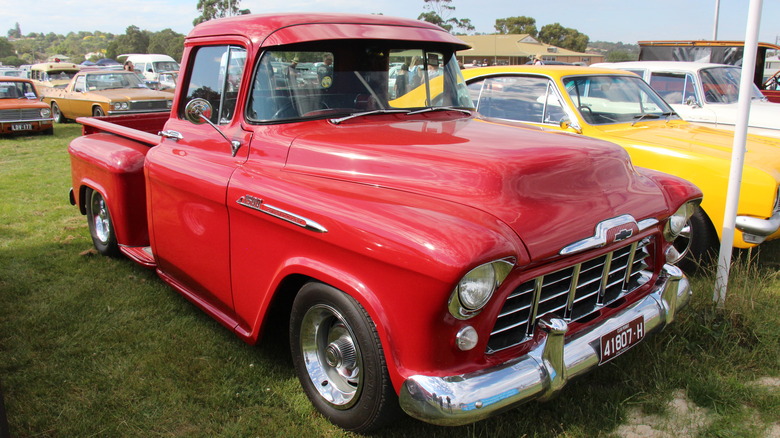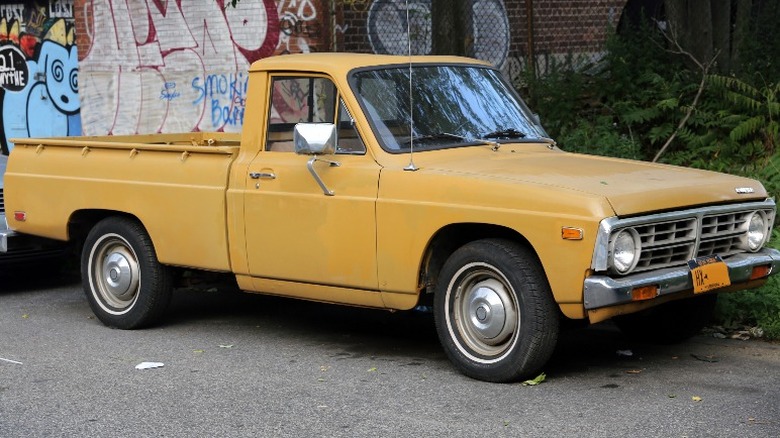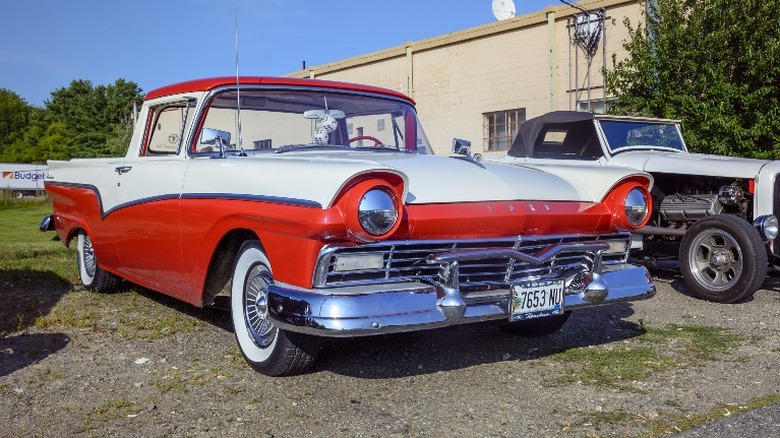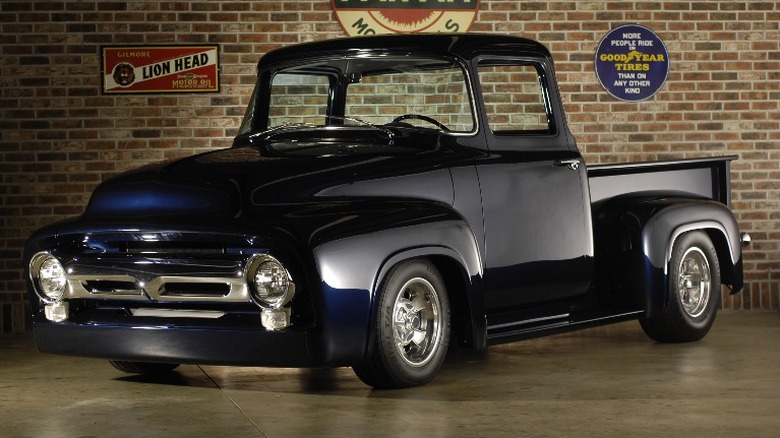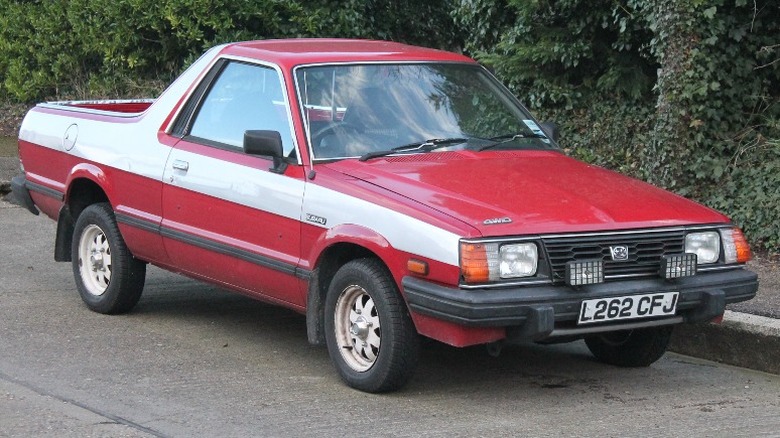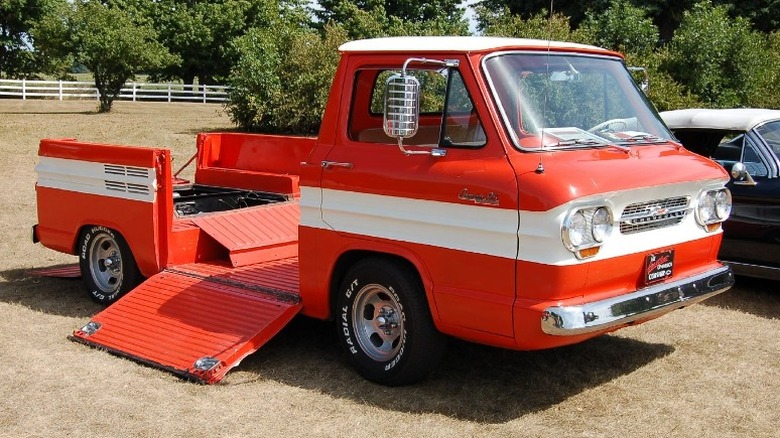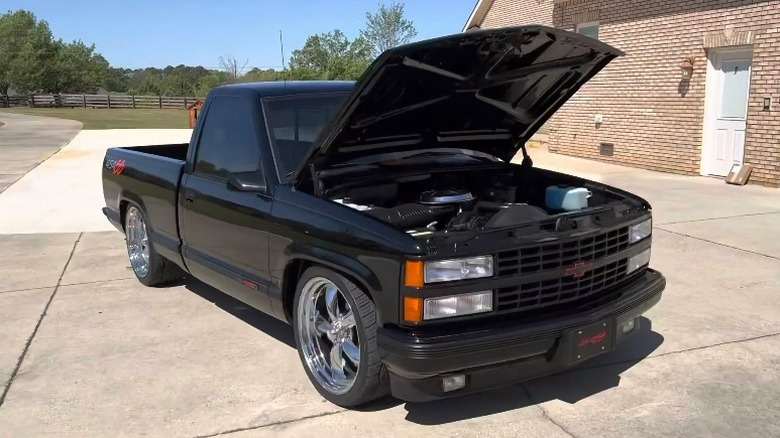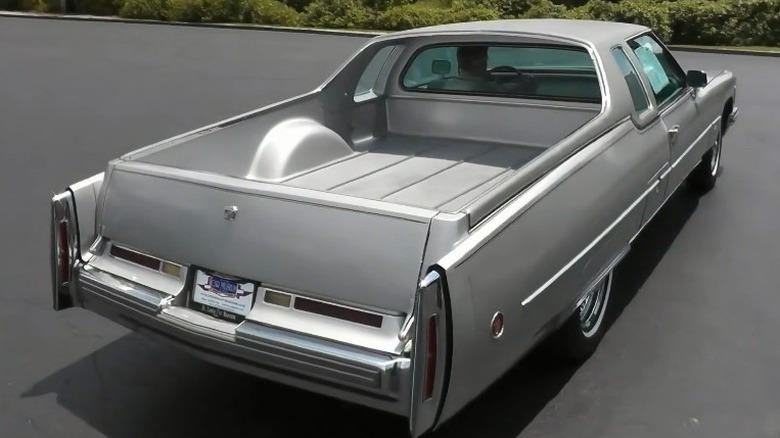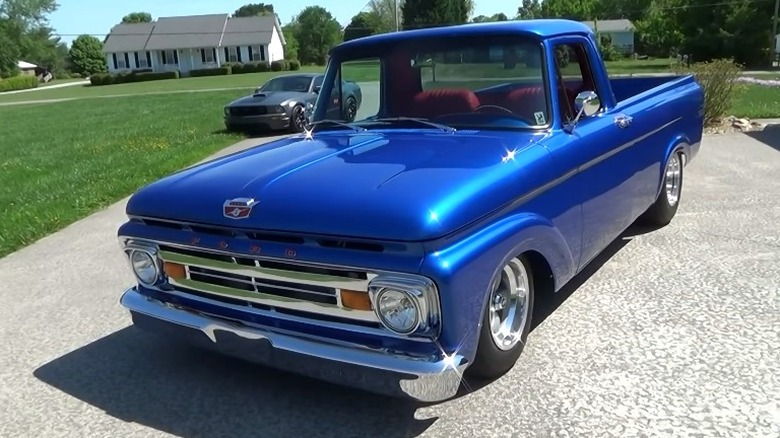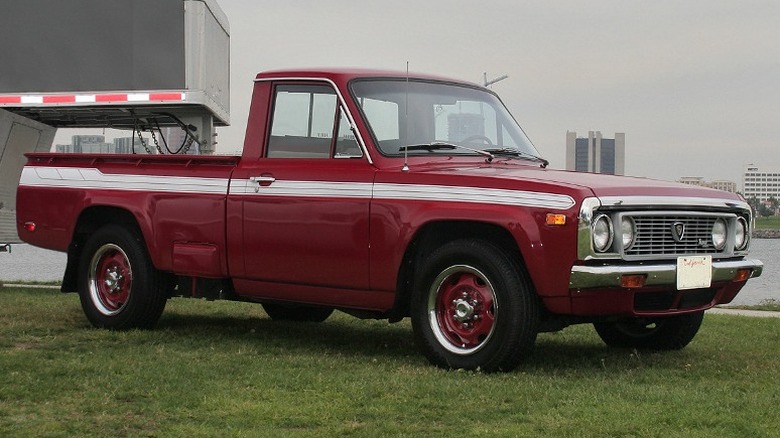10 Classic Pickup Trucks That Are A Total Waste Of Money
Pickup trucks were originally designed to do work. They hauled lumber to house-building projects, carried gravel to road construction jobs, and brought feed to livestock. Trucks were built to take some abuse and perform duties most car owners would hesitate to do with their prized passenger vehicles. Vintage pickup trucks were never intended to become classics.
The vintage trucks lack the collectability appeal of the '60s and '70s muscle cars or Italian exotics. While a few have high-performance capabilities, almost none boasts distinguished racing heritages, and they offer much less nostalgia for enthusiasts wanting to drive the same car they did in high school. As a result, the market for restored pickup trucks is significantly limited, and hot rod conversions built to an owner's specific taste rarely find a buyer willing to pay what they cost to customize.
Buying an older pickup truck to restore, even if it is merely for personal enjoyment, is not without its perils. Rust is prevalent in older trucks and can be expensive to repair. The primitive engineering used for older pickups, including ladder frames and solid rear axles suspended on leaf springs, means a stiff ride to go with manual steering, roll-up windows, and almost no sound insulation. Here are 10 classic pickup trucks that seldom make a good investment due to their inferior design, poor quality, or lack of appeal to hotrodders.
[Featured image by Sicnag via Wikimedia Commons | Cropped and scaled | CC BY 2.0]
1972 Ford Courier
In the early 1970s, all three big American car manufacturers chose to import Japanese-made small pickups into North America and badge them with their own brand in response to the early '70s oil crisis and rising fuel costs. Chrysler sold the Mitsubishi Forte under the names Plymouth Arrow Pickup and Dodge D-50/Ram 50. General Motors offered the LUV based on the Isuzu Faster, and Ford imported the Mazda Proceed, selling it under the Courier badge.
Despite the 1964 Lyndon Johnson 25% "chicken tax" tariff on imported light trucks, the Courier sold well for Ford from 1972 to 1982. Ford circumvented the chicken tax by importing the pickup in a "cab chassis" configuration, composed of the entire light truck less the truck bed. The vehicle was subject only to a 4% tariff and after arrival in the U.S., the cargo bed was attached to the chassis, and the vehicle was sold as a light truck.
In 1972, the no-frills Courier equipped with a 1.8-liter inline-four connected to a four-speed manual transmission (Ford offered an automatic gearbox a year later) sent a paltry 74 horsepower to the rear wheels. Buyers often selected a minitruck over a full-size pickup for its price and fuel economy, even though they sacrificed load-hauling capacity and interior comfort. The base model Courier offered power steering, power brakes, air conditioning, and a push-button AM radio only as options.
[Featured image by Mr.choppers via Wikimedia Commons | Cropped and scaled | CC BY-SA 3.0]
1947 to 1955 Chevrolet 3100
The halt in civilian car production during World War II created a pent-up demand for new designs when the war ended. Although automakers never stopped producing trucks during the war (3.2 million military transport vehicles from 1939 through 1945), buyers of light trucks also yearned for new models with the return of peacetime.
In 1947, GM introduced its new "Advance Design light-duty" post-war pickup truck, offering an attractive new style compared to pre-war models and many practical car-like features not found in the older models. Modifications included a redesigned hood that opened in the front rather than the traditional split hood, which improved engine access. A larger fixed glass windshield replaced the swing-out vented version, and the wipers were mounted on the cowl instead of hanging from up above. The door hinges were hidden and no longer visible from the outside of the pickup. Chevrolet also added a fresh-air combination heater and defroster system, which cycled outside air through the cab and out via rear cabin vents.
However, the primitive haulers included just basic power output. The Chevy truck was equipped with a 216-cubic-inch, straight-six engine until 1954 when the automaker upgraded the mill to a 235 six-cylinder with full-pressure oiling and insert bearings. Chevrolet pickups were fitted with a standard three-speed synchromesh transmission or an optional four-speed. In 1954, the automaker included a heavy-duty three-speed and the Hydra-Matic automatic transmission. No V8 models were available. Despite the new models offered by Chevrolet's Advanced Design, competitors offered better features for less money, such as Ford's new Overhead Valve V8 engine introduced in 1954.
1957 Ford Ranchero
The idea was creative: combine the comfort and features of an automobile with the utility and convenience of a pickup truck. While the Ford Ranchero and Chevrolet El Camino are perhaps the best-known coupe utilities, the earliest combination car-truck appeared in 1934 with the Hudson Terraplane Pickup Express.
Ford introduced the Ranchero in December 1956, promoting it as "More Than a Car, More Than a Truck!" The Ranchero is based on the 116-inch wheelbase, two-door Ford Ranch Wagon with the rear section of the roof removed and a bed liner placed over the floor pan. The design featured long doors, a built-in tailgate, and a 6-foot bed with a load capacity of 1,190 pounds that could carry more cargo than an F150 pickup. Ford offered the 1957 Ranchero with a 22-cubic-inch, six-cylinder engine or 272 and 292-cubic-inch OHV V-8s. In 1958, Ford removed the 272 option but added a 352-cubic-inch engine.
One disadvantage of the Ranchero car-truck design is the cargo-bed removable panels which weaken as the body twists under heavy loads. When the Ranchero's cargo space is empty, the weight distribution is skewed toward the front resulting in oversteer, less downforce on the rear wheels, and less road grip. The car-truck handles better when the cargo area is loaded creating more downforce on the rear wheels, although the extra weight impacts acceleration.
1956 Ford F-100
Ford produced the F-100 pickup truck with a wraparound windshield for only one year: 1956. In the final year of the second generation (1953-1956), some enthusiasts claimed it was the best-looking pickup truck ever built. Furthermore, the pickup truck included creature comforts such as sun visors, a dome light, and armrests, not found in first-generation models. The 1956 model boasted electric windshield wipers that replaced the vacuum-operated versions.
The automaker also made significant upgrades to the suspension over the first generation. To improve ride quality, longer leaf springs were used with both the twin-I-beam front axle suspension and the semi-elliptic six-spring configuration in the rear. Ford also moved the front suspension back to give the pickup a tighter turning radius. The basic 1956 F-100 came with a 223-cubic-inch Mileage Maker Inline Six producing 137 horsepower. However, Ford also provided an optional 272-cubic-inch Y-block V-8 with a four-barrel carburetor that generated 167 horsepower. Ford offered a three, four, or five-speed manual transmission as well as the "Ford-O-Matic."
The limited production of the new body style and demand by pickup truck collectors has driven the price up in recent years. Restored stock versions range from $20,000 to $50,000 depending on overall condition, originality, and mileage. Custom hot rod models can fetch even more. According to Conceptcarz.com, in 2023 the median price for a 1956 Ford F-100 was $50,600 and the highest price sale was $187,000 — in 2022, the pickup sold for a median price of $73,700 and a high of $214,500.
1978 Subaru BRAT
While pickup truck collectors and enthusiasts can debate for hours about which category the Subaru BRAT (Bi-Drive Recreational All-terrain Transporter) fits best, most would agree the vehicle achieved subpar performance as either a coupe-utility or a pickup. The U.S. government classified the Subaru BRAT as a truck, which subjected it to the substantial 25% "chicken tax" import tariff levied on light-duty trucks. However, Subaru came up with a solution to avoid the costly tax by installing rear-facing jump seats in the BRAT's cargo bed changing it to the passenger car category with merely a 2.5% tariff. The ridiculous rear-facing seats not only created a disorienting ride for passengers, but subjected them to wind-blown cold conditions even on a summer day.
The BRAT included other quirky features such as a spring-loaded hidden door providing a sidestep into the carpeted cargo bed, and the spare tire mounted in the engine bay next to the firewall. Launched in 1978, the car-truck shared its underpinnings and the part-time all-wheel-drive system with the Subaru Leone station wagon. Subaru offered only one engine option, a 1.6-liter EA71 OHV H4 that produced 67 horsepower and 81 pound-feet of torque, connected to a standard four-speed manual transmission. A few years later, Subaru upgraded the BRAT to 1.8 liters generating 73 horsepower and 94 pound-feet of torque.
Subaru exported the BRAT to the U.S. for only 10 years, from 1978 to 1987. Although a 1978 BRAT with low milage sold for a whopping $46,198 back in 2018, today most sell for much less. Recently BRAT sales have ranged from $8,700 to $20,000.
[Featured image by Charlie from United Kingdom via Wikimedia Commons | Cropped and scaled | CC BY-SA 2.0]
1961 Chevrolet Corvair 95 Rampside and Loadside
Corvair 95 trucks followed the design of Corvair passenger cars, featuring an air-cooled, rear-mounted, flat-six engine sending 80 horsepower to the rear wheels via a three-speed synchromesh transaxle. Despite the seemingly inadequate horsepower, both pickups offered a 4,700-pound gross vehicle weight rating, which gave them a three-quarter-ton payload capacity.
The first production Corvair 95 models were fitted with a front suspension borrowed from full-size Chevrolets. However, the automaker later switched to the full-size pickup setup and employed a heavy-duty version of the swing-axle rear suspension. The pickup trucks feature a two-door cab and an integrated double-walled cargo box measuring 105 inches by 45 inches. The semi-unitized construction used a subframe to support the cargo area. To make room for the mill, Chevrolet raised the back end of the cargo area floor on both the Rampside and Loadside models, making access with a traditional rear tailgate difficult. However, on the Rampside, a section of the passenger side of the truck was hinged at the bottom, allowing it to form a ramp to the cargo bay. A rubber trim on the edge prevented scratches on the paint when the ramp was lowered.
The awkward-looking flat-face pickups sold well when first introduced, with a total production of 13,262 units. Over 80% of the first-year Corvair 95s sold were Rampsides. Sales declined to 4,471 in the following year with Loadside sales at a trivial 369. The pickup production numbers continued to decline until none were made in 1965. According to Classic Cars, a 1961 Chevrolet Corvair 95 Rampside can be purchased for under $15,000.
[Featured image by Joe Ross via Wikimedia Commons | Cropped and scaled | CC BY-SA 2.0]
1990 to 1993 Chevrolet 454 SS
In 1990, Chevrolet equipped its lightweight half-ton pickup truck with a big-block 454-cubic inch L19 engine featuring electronic fuel injection (EFI). The mill initially produced 230 horsepower and 385 pound-feet of torque but was upgraded to 255 horsepower and 405 pound-feet of torque for the 1991-1993 model years. A three-speed Turbo Hyda-Matic automatic transmission sent power to the rear wheels via a limited-slip differential. The 454 engine is best known as the power source for the 1970-1974 Corvette, but Chevrolet also installed it in the Caprice, Chevelle, and El Camino. Despite the engine's formidable displacement, the truck's performance was mediocre at best, accelerating to 60 mph in 7.1 seconds and reaching the quarter-mile in 15.7 seconds at 87 mph.
The Chevrolet 454 SS was one of the performance-oriented pickups that followed a popular formula in the early '90s: stuff a powerful big-block engine into a small lightweight pickup platform. The front-favored weight distribution made them ideal for tire burnouts. While the 454 V8 offered time-tested reliability, it was also known for a few issues, including problems with the cylinder head, exhaust manifolds, and backfiring. The engine was also subject to overheating, especially in trucks that hauled heavy loads.
Furthermore, the 454 pickup truck was a gas guzzler, with an estimated fuel economy of 10 mpg city and 11 mpg highway. According to Hagerty, although a Concours-rated (best in the world) 1990 Chevrolet 454 SS can fetch $92,300 at auction, most sell for much less: a truck with an Excellent rating sells for $63,800, Good rating for $32,600, and Fair rating for $13,900.
1975/76 Cadillac Mirage
Cadillac has a long history of producing the most luxurious and high-quality American vehicles on the market. Today, while most other American auto manufacturers include pickup truck models in their line of vehicles, Cadillac remains focused on producing sedans and SUVs. However, in 1975, the automaker ventured into the utility vehicle segment, albeit indirectly, when Traditional Coach Works built the Mirage, a hybrid between a coupe and a pickup truck, and sold them via regular Cadillac dealerships.
Powered by a massive 500-cubic-inch V8 that produced 200 horsepower and 400 pound-feet of torque, the car-truck was equipped with all the options, including an automatic transmission, power brakes, power steering, power windows, power seats, and power locks. The ample cargo bed could accommodate a full-size sheet (4x8 feet) of plywood, and a few units were built with a side-access door to a golf bag storage compartment.
However, the Mirage appealed to very few buyers. The Mirage has been described by the Herald Weekly as a Cadillac Coupe de Ville with the back seat removed and a long flatbed slapped in its place, with "very little functionality both as a truck and as a vehicle." Cadillac reported sales of just a few hundred units. The Cadillac Mirage MSRP was nearly double the price of a standard Coupe de Ville, which certainly had a significant impact on customer demand. According to Classic.com, 1975 and 1976 Cadillac Mirages sold for an average of $30,113 with the lowest at $7,150 and the highest at $49,500.
1961 to 1963 Ford Unibody F-Series
Today, most new cars are built with a unibody construction, and many pickup trucks also use a unibody frame, such as the Hyundai Santa Cruz, Honda Ridgeline, and Ford Maverick. Ford employed the design early, building the F-series pickup trucks from 1961 to 1963 with the unibody design when most manufacturers used the traditional separate body and chassis configuration.
Ford's unique version consisted of the pickup cab and bed built as a single entity mounted on a ladder frame. The automaker's decision to adopt the design was motivated by several factors. The manufacturing process required fewer welds and the one-piece stamping was more cost-effective than building the structure with several smaller pieces. The pickup was easier to build and paint, making assembly costs less expensive. The larger cargo loading area gave Ford promotional material to compete with other truck manufacturers.
A standard 223-cubic-inch straight six producing 137 horsepower, connected to a three or four-speed manual transmission, powered the pickup trucks. Ford also offered an optional 292-cubic-inch V8 generating 186 horsepower and the three-speed Ford-O-Matic automatic transmission. Ford included other new features in 1961 to 1963 F-Series trucks including wider-swinging cab doors, the removal of wrap-around windshields to improve cab entry and exit, and additional cab soundproofing.
However, Ford experienced structural integrity problems with its exclusive design. Loaded with cargo, the pickup bodies would often distort excessively and occasionally split apart. The automaker discontinued the unibody design after only three years of production and returned to a more traditional body-on-frame configuration.
1974-1977 Mazda Rotary Pickup
Mazda gained notoriety as the rotary engine manufacturer with its highly successful RX7 and RX8 sports cars. However, the automaker also equipped other models with the unique engine, including its pickup truck.
Introduced in 1974, the Mazda Rotary Engine Pickup (REPU), featuring distinctive round taillights and flared fenders, was the world's first and only Wankel rotary-powered pickup. The smooth and quiet 1.3-liter rotary engine, weighing a mere 130 pounds, produced 110 horsepower and 127 pound-feet of torque. The lightweight of the truck (curb weight of 2,800 pounds) and an engine that redlined at 7,000 revolutions per minute gave the pickup remarkable acceleration. MotorTrend tests showed the REPU reaching 60 mph in 8.9 seconds.
A rotary engine generates its maximum power at higher revolutions per minute, meaning it sacrifices torque at lower revolutions per minute. While the vigorous engine performance of the REPU was impressive, the rotary engine did not have enough torque to move heavy loads. However, in addition to the load limitation, the REPU's poor fuel economy impacted sales. Rotary engines typically consume more fuel than piston engines because the long combustion-chamber shape and low compression ratio reduce the thermodynamic efficiency. The EPA rated the rotary engine pickup at about 10 mpg, although the agency's tests showed 12-13 mpg. The mileage was about the same as a powerful V8-equipped American pickup of the same period that could haul heavier loads. Although the Mazda REPU was popular for a short period, in the 1970s, gas shortages inspired buyers to purchase more fuel-efficient vehicles.
[Featured image by Rex Gray from Southern California via Wikimedia Commons | Cropped and scaled | CC BY-SA 2.0]
